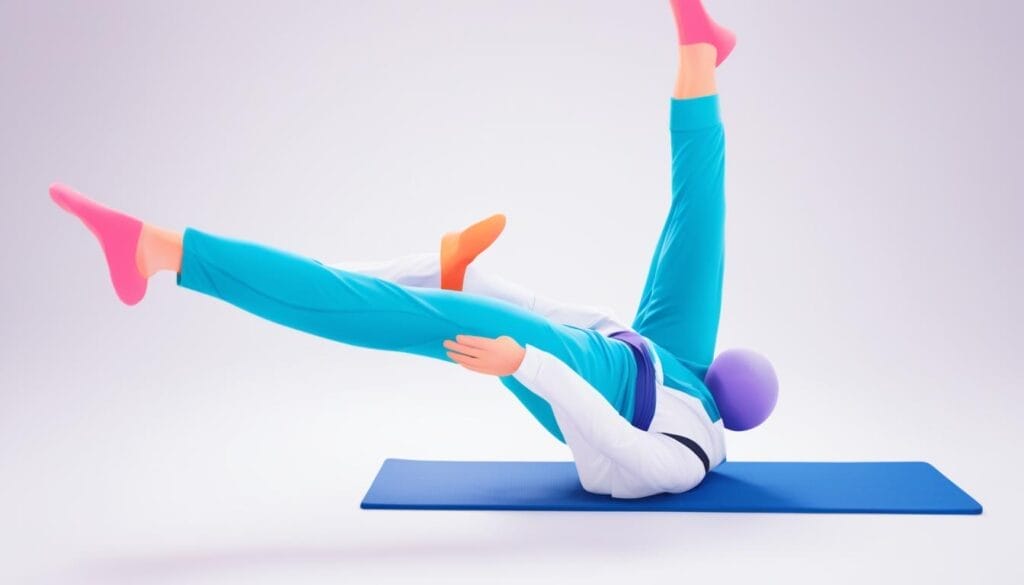Life brings many unexpected challenges. It could be a tough job or a busy schedule. These can lead to a lot of stress and harm our mental health. I’ve experienced this quite a lot.
There was a time I couldn’t stay calm at all. My head was full of worries and stress. It made me feel really tired and lost. That’s when I learned how useful flexibility and relaxation can be to fight stress and keep balance.
I started doing mindfulness, exercises, and relaxation therapies. With time, I let go of rigid thoughts and became more open. This change really improved my life.
So, if you’re looking to overcome stress and negative thoughts, I welcome you. Let’s look into flexibility and relaxation together. These practices can help you feel calmer and take care of your mind.
Key Takeaways:
- Practicing flexibility and relaxation techniques can help manage stress and promote mental wellness.
- Mindfulness and physical exercises can help challenge rigid thinking patterns and foster adaptable mindsets.
- Exploring relaxation therapies and incorporating them into daily routines can bring about a sense of calmness and balance.
- Seeking professional help and support is crucial in overcoming rigid thinking patterns and achieving a happier life.
- Change takes time and effort, but the positive impact on your well-being is worth it.
What is Rigid Thinking?
Rigid thinking means finding it hard to deal with things that surprise us and believing we know how things will turn out. This way of thinking can harm our personal and work lives, as well as our mental health. When we think rigidly, we stick to certain ways of thinking and cultural norms. This stops us from being flexible and from welcoming new ideas.
Cognitive biases are ways of thinking that influence how we judge and make decisions. They are like mental shortcuts. These biases can stop us from seeing things from others’ points of view or from accepting new facts. Consequently, we may not like changes or new ideas that don’t fit our usual ways.
Rigid thinking can be bad for our jobs too. It can make us poor at solving problems and less creative. Working with others might also be tough and it could make adapting to new work changes hard. This could slow down our career progress.
Moreover, rigid thinking is also damaging to our mental health. Being unbendable and not questioning our beliefs can cause stress, anxiety, and unhappiness. It can make us feel angry or like we’re stuck in a hard life. This can also lead to being depressed and not feeling satisfied with life.
It’s crucial to spot and challenge our rigid thoughts for more flexibility in life. To change, we have to be aware of our mental shortcuts and usual beliefs. This means being open to new ideas. Repeatedly reflecting and trying to see things differently can help us become better at handling surprises and change. This leads to a happier mind and a more satisfying life.
“The greatest obstacle to progress is not ignorance, but the illusion of knowledge.” – Daniel J. Boorstin
Key Signs of Rigid Thinking
It’s important to spot signs of rigid thinking. This includes behaviours and thoughts that stop us from changing or adapting well. Certain signs show a person might think too rigidly:
- The need to control situations: Rigid thinkers often want to control everything. They make strict rules and routines to keep life orderly.
- Sticking to defined rules or routines: Such people feel safe when following a set pattern. They get nervous if something changes.
- Ignoring the ideas and thoughts of others: They ignore different perspectives, sticking to their own thoughts and beliefs.
- Resisting change: They find change hard and prefer things to stay as they are. New situations might scare or worry them.
- Difficulty in accepting other viewpoints: It’s tough for them to see other people’s views. They might get defensive if someone disagrees.
- Feeling compulsions to do certain actions: They might feel they must do certain actions or rituals. They believe it keeps things in order.
Seeing these signs helps us be more flexible. We can start thinking in new ways by challenging these patterns. This leads to growth and a better outlook on life.

Case Study: Emma's Struggle with Rigid Thinking
“I used to think everything must go as planned. Any change made me very stressed. Learning things don’t always go as planned slowly helped me feel calmer. Therapy and thinking about my thoughts finally made me more open. Now, I feel more peaceful and adaptable.”
This story shows the difficulties with rigid thinking. By working hard and getting help, breaking this thinking is possible. It means you can be more flexible and enjoy life more.
| Key Signs of Rigid Thinking | Impact on Personal and Professional Life |
|---|---|
| The need to control situations | Can lead to micromanagement and difficulties in delegating tasks. May hinder teamwork and collaboration. |
| Sticking to defined rules or routines | May limit creativity and innovation. Can make it challenging to adapt to new situations or technologies. |
| Ignoring the ideas and thoughts of others | Can strain relationships and hinder effective communication. May lead to missed opportunities for growth and learning. |
| Resisting change | May result in missed opportunities for personal and professional development. Can cause unnecessary stress and anxiety. |
| Difficulty in accepting other viewpoints | Can lead to conflicts and strained relationships. May hinder problem-solving and decision-making processes. |
| Feeling compulsions to do certain actions | Can interfere with daily life and productivity. May contribute to anxiety disorders or obsessive-compulsive tendencies. |
This table shows how rigid thinking affects our lives. Recognising these signs and their effects is the first step. It then helps us choose to think in more open and flexible ways.
Disadvantages of Rigid Thinking
Rigid thinking can harm our lives in many ways. It can make us lonely, limit problem-solving, and cause stress. It affects how we see the world and lowers our quality of life.
It often leads to being alone. If we’re too stuck in our ways, we find it hard to connect with others. This makes us feel isolated and stops us from building strong relationships.
Dealing with change becomes hard for those who think rigidly. They’re not open to new ideas or ways of doing things. So, when life throws them a curveball, they struggle to adapt, stopping their personal growth.
Wanting too much control can bring us anxiety and stress. Rigid thinkers hate not knowing what’s next. This worry and fear can really mess with their minds and bodies.
These folks might not be great at solving problems. Being stuck in their ways makes it hard to find new solutions. They often miss out on creative answers that could help them in tough times.
Rigid thinking can also make us pretty negative. Always sticking to our own rules can make us see the worst in everything. This hurts our confidence and can keep us in a bad emotional loop.
Overall, rigid thinking robs us of chances to grow. It holds us back in our careers, stops us from making deep connections, and keeps us from being truly happy.
Breaking Free from Rigid Thinking
“The measure of intelligence is the ability to change.” – Albert Einstein
To beat the downsides of rigid thinking, we need to be more open. It’s vital to see the flaws in how we think. This opens the door to change.
Start by checking your own thoughts. Look at why you think the way you do. Then, question if these ideas are really true. This can help you think in new, better ways.
Doing things like meditation can calm your mind and make you more aware. This, along with deep breathing and yoga, can make you more open to change.
Getting help from a therapist is also a smart move. They can guide you in fighting the deep issues in your thinking. With their help, you can learn new ways to think and see the world.
Challenging your rigid thoughts is key to breaking free. By being more open and flexible, you can solve problems better. This leads to clearer thinking and a happier life.
Tips to Overcome Rigid Thinking
Overcoming rigid thinking takes patience and an open mind. Below are tips to help you become more flexible:
- Practice Relaxation Techniques: Try skills like deep breathing, muscle relaxation, and mindfulness. These help calm your mind, lower stress, and open it to new ideas.
- Try Unique Ways to Accomplish Tasks: Step away from your usual tasks. Try different methods or tools. Looking at things in a new way can break old habits of thinking.
- Change Strong Beliefs: Realise your beliefs can change. Talk to others or try new things. This helps you see things from different perspectives.
- Encourage Flexible Thinking: Seek different viewpoints. Look at situations from various angles. This helps challenge your first thoughts.
- Embrace Patience: It takes time to change how you think. Be patient with yourself. It’s okay to face challenges as you learn.
Being flexible in your thinking leads to better problem-solving and growth. So, follow these tips. Aim for a mindset that’s open and welcoming to change.
Empower yourself with flexibility
Overcoming rigid thinking empowers you with flexible thought. This way, you can innovate and grow. Flexibility helps you adapt, find new solutions, and face life’s trials.
Embracing discomfort and learning
Challenging fixed beliefs and accepting change can be tough. Yet, this challenge is where real growth happens. It opens the door to new understandings.

The power of flexibility in all aspects of life
Flexibility is key in many life areas. It’s vital for changing work fields, strong relationships, and coping with surprises. Being flexible boosts your problem-solving and well-being.
By adopting these tips regularly, you empower yourself. Tackling rigid thought can make you navigate life’s ups and downs with more grace and liberty.
Relaxation Techniques for Flexibility and Relaxation
There are various techniques to achieve flexibility and relaxation. They help soothe the mind and body. Adding them to your day gives a much-needed break from stress. Here are techniques that calm and improve your well-being.
Deep Breathing
Deep breathing releases tension and makes you relax. Focus on your breath, taking slow, deep breaths. Find a quiet spot, sit comfortably, and breathe in slowly through your nose. Hold a moment, then breathe out slowly. Do this for a few minutes for the best effect.
Progressive Muscle Relaxation
To relax, tense then release each muscle group. Start by tensing, then release. Notice how relaxed muscles feel different. Continue through your body, relaxing shoulders, arms, and legs. This method helps get rid of physical tension for deep relaxation.
Mindfulness Meditation
Mindfulness means focusing on the now without judgement. It could mean watching your breath or your body. This practice teaches your mind to let go of distractions. Find a quiet place, sit, and focus. When you wander, gently come back to now.
Visualisation
Picture peaceful scenes like a beach in your mind. With your eyes closed, breathe deeply and see yourself there. Use all your senses to feel calm. This is great for lowering stress and finding peace.
Yoga and Tai Chi
Yoga or Tai Chi combines movement and breathing for relaxation. They help release body tension and calm your mind. Choose yoga’s active flows or Tai Chi’s slow moves. They both offer physical and mental benefits.
Aromatherapy
Aromatherapy uses scents like lavender to relax. Use oils in a diffuser, bath, or on your skin (mixed with another oil). These scents calm stress and anxiety.
Disconnecting from Technology
Regular breaks from technology are crucial for self-renewal. Too much screen time can tire your mind. Find times to be tech-free and do relaxing activities like reading or walking.
Use these techniques every day to manage stress, get more flexible, and feel calm and well.

| Relaxation Technique | Description |
|---|---|
| Deep Breathing | Involves taking slow, deep breaths to activate the body’s relaxation response. |
| Progressive Muscle Relaxation | Systematically tensing and releasing different muscle groups to promote relaxation. |
| Mindfulness Meditation | Focusing attention on the present moment without judgment to cultivate relaxation and mental clarity. |
| Visualisation | Creating mental images of peaceful scenes to evoke relaxation and tranquillity. |
| Yoga and Tai Chi | Combining movement, stretching, and deep breathing to promote relaxation, flexibility, and balance. |
| Aromatherapy | Using essential oils with calming properties to alleviate stress and anxiety. |
| Disconnecting from Technology | Taking breaks from technology to recharge and engage in activities that promote relaxation. |
Incorporating Relaxation into Daily Routine
Looking after our mental and physical health is crucial. To do this, we need to include relaxation techniques in our daily lives. In our busy world, taking time to unwind is key. We will now look at simple ways to find calm and balance every day.
The Power of Deep Breathing
Deep breathing exercises are a simple yet powerful way to relax every day. They help your body respond to stress positively. Finding time to focus on your breath is vital. Breathe in deeply through your nose, feel your belly rise. Then, breathe out slowly through your mouth. Do this a few times when you need to relax.
The Practice of Mindfulness Meditation
Mindfulness meditation is a great addition to your daily routine. It involves being in the present moment without judging your thoughts. Sit quietly, close your eyes, and focus on your breath. When thoughts come, gently guide your mind back to your breath. This practice can lower stress, boost focus, and improve your mental health.
Take a Walk in Nature
Walking outside is excellent for both your mind and body. Make a daily habit of walking in nature. It could be a park walk or a countryside hike. This time allows you to escape technology and enjoy fresh air and nature. It lowers stress, lifts your mood, and makes you feel better overall.

Find What Works for You
Relaxation is different for everyone. Try various methods to see what you enjoy. Ideas include writing a journal, listening to calm music, yoga, or aromatherapy. The goal is to find time each day for your mental and physical well-being.
| Benefits of Incorporating Relaxation into Daily Routine | Keywords |
|---|---|
| Reduces stress levels | mental and physical health, relaxation, daily routine |
| Promotes a sense of calmness | mental and physical health, relaxation, deep breathing |
| Improves overall well-being | mental and physical health, relaxation, meditation |
| Enhances focus and concentration | mental and physical health, relaxation, mindfulness |
| Boosts mood and happiness | mental and physical health, relaxation, walk in nature |
Summing It Up
Being flexible and learning to relax can make us happier. It helps us see new options and welcome changes into our lives. This shift doesn’t happen quickly, but over time, we grow more open-minded.
Getting help from a professional can be really beneficial. A therapist or coach can guide and support us. They help us get over our own obstacles and teach us how to be more adaptable.
Being flexible doesn’t mean giving up on what’s important to us. It’s about welcoming new thoughts and ways of looking at things. By being open and ready to change, we can lead a more joyful life. Taking this step can lead us to a brighter, more relaxed future.
FAQ
What is rigid thinking?
Rigid thinking means finding it hard to face surprises. People with this behaviour think they can always predict how things will turn out. This way of thinking can cause a lot of problems like getting too upset, feeling down a lot, and thinking life is always troubling.
What are the key signs of rigid thinking?
Signs of rigid thinking are wanting to control everything. It means sticking strictly to rules or routines without considering other ideas. People who think this way also really struggle with change, find other people’s opinions hard to accept, and often feel they must do certain things over and over.
What are the disadvantages of rigid thinking?
Rigid thinking has many downsides. It can mean losing touch with others and finding it hard to deal with new places or situations. It often brings on stress and anxious feelings, makes it tough to solve problems well, and generally leads to more negative ways of thinking. All this can make life less enjoyable.
What are some tips to overcome rigid thinking?
To beat rigid thinking, you can try to relax more and find new, creative ways of doing things. It’s also helpful to be open to changing your strong opinions and to listen to other points of view. Remember, adapting a more flexible mindset takes time. So, be patient with yourself as you work on it.
What are some relaxation techniques for flexibility and relaxation?
There are many relaxation methods that can make you more flexible and relaxed. You might try deep breathing, letting go of tense muscles step by step, focusing on the present moment, imagining peaceful scenes, doing yoga or Tai Chi, using nice scents, and taking breaks from screens and internet. These activities can really help.
How can I incorporate relaxation into my daily routine?
Making relaxation part of your daily life is crucial for both your mind and body. You can do this by doing simple breathing exercises, meditation, or simply walking in natural surroundings. These small habits can really make a big difference.
What is the conclusion about embracing flexibility and relaxation techniques?
Choosing to be open and relaxed can truly make your life better and more satisfying. It’s good to break free from rigid ways of thinking and look for support, if you need it. Remember, personal growth needs time and work, but it’s always worth the effort for a happier life.
Source Links
Share Me:
READY TO UNLEASH
YOUR BEST SELF?
Click “Sign Me Up!” And Start Your Fitness Transformation!





